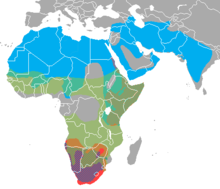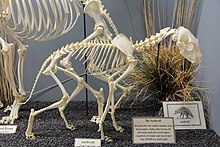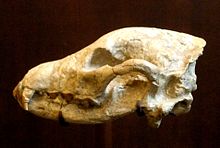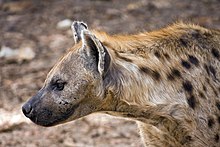
A | B | C | D | E | F | G | H | CH | I | J | K | L | M | N | O | P | Q | R | S | T | U | V | W | X | Y | Z | 0 | 1 | 2 | 3 | 4 | 5 | 6 | 7 | 8 | 9
| Hyenas Temporal range: Early Miocene – recent
| |
|---|---|

| |
| The four extant species of hyena, clockwise from upper left: spotted hyena (Crocuta crocuta), brown hyena (Parahyaena brunnea), aardwolf (Proteles cristata) and striped hyena (Hyaena hyaena) | |
| Scientific classification | |
| Domain: | Eukaryota |
| Kingdom: | Animalia |
| Phylum: | Chordata |
| Class: | Mammalia |
| Order: | Carnivora |
| Suborder: | Feliformia |
| Superfamily: | Herpestoidea |
| Family: | Hyaenidae Gray, 1821 |
| Type genus | |
| Hyaena Brisson, 1762
| |
| Genera | |
| |

| |
| Synonyms | |
| |

Hyenas or hyaenas (/haɪˈiːnəz/ hi-EE-nəz; from Ancient Greek ὕαινα, hýaina)[1] are feliform carnivoran mammals belonging to the family Hyaenidae /haɪˈɛnɪdiː/. With just four extant species (each in its own genus), it is the fourth-smallest family in the order Carnivora and one of the smallest in the class Mammalia.[2] Despite their low diversity, hyenas are unique and vital components of most African ecosystems.[3]
Although phylogenetically closer to felines and viverrids, hyenas are behaviourally and morphologically similar to canids in several elements due to convergent evolution: both hyenas and canines are non-arboreal, cursorial hunters that catch prey with their teeth rather than claws. Both eat food quickly and may store it, and their calloused feet with large, blunt, nonretractable claws are adapted for running and making sharp turns. However, hyenas' grooming, scent marking, defecation habits, mating and parental behavior are consistent with the behavior of other feliforms.[4]
Hyenas feature prominently in the folklore and mythology of human cultures that live alongside them. Hyenas are commonly viewed as frightening and worthy of contempt. In some cultures, hyenas are thought to influence people's spirits, rob graves, and steal livestock and children.[5] Other cultures associate them with witchcraft, using their body parts in traditional medicine.[6]
Evolution
Origins
Hyenas originated in the jungles of Miocene Eurasia 22 million years ago, when most early feliform species were still largely arboreal. The first ancestral hyenas were likely similar to the modern African civet; one of the earliest hyena species described, Plioviverrops, was a lithe, civet-like animal that inhabited Eurasia 20–22 million years ago, and is identifiable as a hyaenid by the structure of the middle ear and dentition. The lineage of Plioviverrops prospered, and gave rise to descendants with longer legs and more pointed jaws, a direction similar to that taken by canids in North America.[7] Hyenas then diversified into two distinct types: lightly built dog-like hyenas and robust bone-crushing hyenas. Although the dog-like hyenas thrived 15 million years ago (with one taxon having colonised North America), they became extinct after a change in climate, along with the arrival of canids into Eurasia. Of the dog-like hyena lineage, only the insectivorous aardwolf survived, while the bone-crushing hyenas (including the extant spotted, brown and striped hyenas) became the undisputed top scavengers of Eurasia and Africa.[7]
Rise and fall of the dog-like hyenas

The descendants of Plioviverrops reached their peak 15 million years ago, with more than 30 species having been identified. Unlike most modern hyena species, which are specialised bone-crushers, these dog-like hyenas were nimble-bodied, wolfish animals; one species among them was Ictitherium viverrinum, which was similar to a jackal. The dog-like hyenas were numerous; in some Miocene fossil sites, the remains of Ictitherium and other dog-like hyenas outnumber those of all other carnivores combined. The decline of the dog-like hyenas began 5–7 million years ago during a period of climate change, exacerbated by canids crossing the Bering land bridge to Eurasia. One species, Chasmaporthetes ossifragus, managed to cross the land bridge into North America, being the only hyena to do so. Chasmaporthetes managed to survive for some time in North America by deviating from the endurance-running and bone-crushing niches monopolized by canids, and developing into a cheetah-like sprinter. Most of the dog-like hyenas had died off by 1.5 million years ago.[7]
Bone-crushing hyenas
By 10–14 million years ago, the hyena family had split into two distinct groups: dog-like hyenas and bone-crushing hyenas. The arrival of the ancestral bone-crushing hyenas coincided with the decline of the similarly built family Percrocutidae. The bone-crushing hyenas survived the changes in climate and the arrival of canids, which wiped out the dog-like hyenas, though they never crossed into North America, as their niche there had already been taken by the dog subfamily Borophaginae. By 5 million years ago, the bone-crushing hyenas had become the dominant scavengers of Eurasia, primarily feeding on large herbivore carcasses felled by sabre-toothed cats. One genus, Pachycrocuta, was a 200 kg (440 lb) mega-scavenger that could splinter the bones of elephants.[7] Starting in the early Middle Pleistocene Pachycrocuta was replaced by the smaller Crocuta and Hyena, which corresponds to a general faunal change, perhaps in connection to the Mid-Pleistocene transition.[8]
Rise of modern hyenas

The four extant species are the striped hyena (Hyaena hyaena), the brown hyena (Parahyaena brunnea), the spotted hyena (Crocuta crocuta), and the aardwolf (Proteles cristata).
The aardwolf can trace its lineage directly back to Plioviverrops 15 million years ago, and is the only survivor of the dog-like hyena lineage. Its success is partly attributed to its insectivorous diet, for which it faced no competition from canids crossing from North America. It is likely that its unrivaled ability to digest the terpene excretions from soldier termites is a modification of the strong digestive system its ancestors used to consume fetid carrion.[7]
The striped hyena may have evolved from Hyaenictitherium namaquensis of Pliocene Africa. Striped hyena fossils are common in Africa, with records going back as far as the Villafranchian. As fossil striped hyenas are absent from the Mediterranean region, it is likely that the species is a relatively late invader to Eurasia, having likely spread outside Africa only after the extinction of spotted hyenas in Asia at the end of the Ice Age. The striped hyena occurred for some time in Europe during the Pleistocene, having been particularly widespread in France and Germany. It also occurred in Montmaurin, Hollabrunn in Austria, the Furninha Cave in Portugal and the Genista Caves in Gibraltar. The European form was similar in appearance to modern populations, but was larger, being comparable in size to the brown hyena.[9]
The spotted hyena (Crocuta crocuta) diverged from the striped and brown hyena 10 million years ago.[10] Its direct ancestor was the Indian Crocuta sivalensis, which lived during the Villafranchian.[11] Ancestral spotted hyenas probably developed social behaviours in response to increased pressure from rivals on carcasses, thus forcing them to operate in teams. Spotted hyenas evolved sharp carnassials behind their crushing premolars, therefore they did not need to wait for their prey to die, and thus became pack hunters as well as scavengers. They began forming increasingly larger territories, necessitated by the fact that their prey was often migratory, and long chases in a small territory would have caused them to encroach into another clan's turf.[7] Spotted hyenas spread from their original homeland during the Middle Pleistocene, and quickly colonised a very wide area from Europe, to southern Africa and China.[11] The eventual disappearance of the spotted hyena from Europe has traditionally been attributed to the end of the last glacial period and a subsequent displacement of open grassland by closed forests, which favoured wolves and humans instead.[12] However, analyses have shown that climate change alone is insufficient to explain the spotted hyena's disappearance from Europe, suggesting that other factors – such as human pressure – must have played a role.[13] This suggests that the events must be seen within the broader context of late-Quaternary extinctions, as the late Pleistocene and early Holocene saw the disappearance of many primarily large mammals from Europe and the world.
Genera of the Hyaenidae (extinct and recent)

The list follows McKenna and Bell's Classification of Mammals for prehistoric genera (1997)[14] and Wozencraft (2005) in Wilson and Reeders Mammal Species of the World for extant genera.[15] The percrocutids are, in contrast to McKenna and Bell's classification, not included as a subfamily into the Hyaenidae, but as the separate family Percrocutidae (though they are generally grouped as sister-taxa to hyenas[16]). Furthermore, the living brown hyena and its closest extinct relatives are not included in the genus Pachycrocuta, but in the genus Parahyaena. However, some research has suggested Parahyaena may be synonymous with Pachycrocuta, making the brown hyena the only extant member of this genus.[17]
- Family Hyaenidae
- Subfamily Incertae sedis
- †Tongxinictis[18] (Middle Miocene of Asia)
- †Subfamily Ictitheriinae
- †Herpestides (Early Miocene of Africa and Eurasia)
- †Plioviverrops (including Jordanictis, Protoviverrops, Mesoviverrops; Early Miocene to Early Pliocene of Europe, Late Miocene of Asia)
- †Ictitherium (=Galeotherium; including Lepthyaena, Sinictitherium, Paraictitherium; Middle Miocene of Africa, Late Miocene to Early Pliocene of Eurasia)
- †Thalassictis (including Palhyaena, Miohyaena, Hyaenictitherium, Hyaenalopex; Middle to Late Miocene of Asia, Late Miocene of Africa and Europe)
- †Hyaenotherium (Late Miocene to Early Pliocene of Eurasia)
- †Miohyaenotherium[19](Late Miocene of Europe)
- †Lycyaena (Late Miocene of Eurasia)
- †Tungurictis[20] (Middle Miocene of Africa and Eurasia)
- †Protictitherium (Middle Miocene of Africa and Asia, Middle to Late Miocene of Europe)
- Subfamily Hyaeninae
- †Palinhyaena[21] (Late Miocene of Asia)
- †Ikelohyaena[22] (Early Pliocene of Africa)
- Hyaena (=Euhyaena,=Parahyaena; including striped hyena, Pliohyaena, Pliocrocuta, Anomalopithecus) Early Pliocene (?Middle Miocene) to Recent of Africa, Late Pliocene (?Late Miocene) to Late Pleistocene of Europe, Late Pliocene to recent in Asia
- Parahyaena (=Hyaena; brown hyena Pliocene to recent of Africa)
- †Hyaenictis[23] (Late Miocene of Asia?, Late Miocene of Europe, Early Pliocene (?Early Pleistocene) of Africa)
- †Leecyaena[21] (Late Miocene and/or Early Pliocene of Asia)
- †Chasmaporthetes (=Ailuriaena; including Lycaenops, Euryboas; Late Miocene to Early Pleistocene of Eurasia, Early Pliocene to Late Pliocene or Early Pleistocene of Africa, Late Pliocene to Early Pleistocene of North America)
- †Pachycrocuta (Pliocene and Pleistocene of Eurasia and Africa)
- †Adcrocuta (Late Miocene of Eurasia)
- Crocuta (=Crocotta; including Eucrocuta; spotted hyena and cave hyena. Late Pliocene to recent of Africa, Late Pliocene to Late Pleistocene of Eurasia)
- Subfamily Protelinae
- †Gansuyaena[24]
- Proteles (=Geocyon; aardwolf. Pleistocene to Recent of Africa)
- Subfamily Incertae sedis
Phylogeny
The following cladogram illustrates the phylogenetic relationships between extant and extinct hyaenids based on the morphological analysis by Werdelin & Solounias (1991),[25] as updated by Turner et al. (2008).[26]
|
